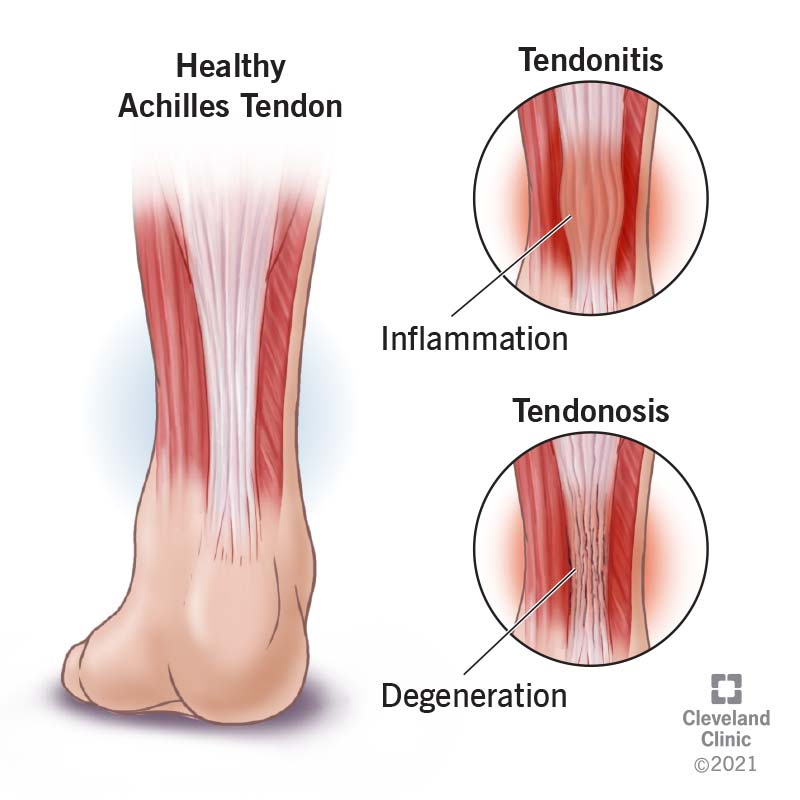An overview of Tendinitis
What is Tendinitis
Tendinitis is inflammation of the thick fibrous cords that attach muscle to bone. These cords are called tendons. The condition causes pain and tenderness just outside a joint.
Tendinitis can occur in any tendon. But it's most common around shoulders, elbows, wrists, knees and heels.

Type of Tendinitis
Achilles tendinitis : The Achilles tendon is a thick band of tissue attaching the heel to the calf muscle. This tendon, which helps a person walk, run, and jump, endures a great deal of stress.
Supraspinatus tendinitis : In supraspinatus tendinitisTrusted Source, the tendon at the top of the shoulder joint becomes inflamed. This causes pain when moving the arm.
Tennis or golfer’s elbow : Lateral epicondylitis, commonly called tennis elbow, causes pain when a person bends their wrist outwards. This pain may radiate down towards the wrist.
de Quervain’s stenosing tenosynovitis : This form of tendinitis happens when the sheath surrounding the tendons between the thumb and wrist becomes inflamed. The tendon sheath thickens and swells, making it painful to move the thumb.
Trigger finger or thumb : Trigger finger is a common condition that happens when a finger clicks when straightened. It becomes fixed in a bent position because the tendon sheath in the palm is thickened and inflamed. This restricts the tendon’s movement, so it cannot move smoothly.
Tendinitis of the wrist : Wrist tendinitis can affect anyone who repeatedly performs the same movements with their wrists. It is common in people who do a lot of typing, writing, and sports like tennis.
What causes tendinitis?
The most common cause of tendinitis is repetitive action. Tendons help you make a certain movement over and over. You may develop tendinitis if you frequently make the same motion while playing sports or working. The risk increases if you perform the motion incorrectly.
Tendinitis can also result from :
1. Aging
2. Injury
3. certain diseases, such as diabetes or rheumatoid arthritis
4. making repetitive motions, such as chopping or typing for long periods
5. having poor posture
6. excessive exercise
Symptoms of tendinitis
The pain from tendinitis is typically a dull ache concentrated around the affected area or joint. It increases when you move the injured area. The area will be tender, and you’ll feel increased pain if someone touches it.
You may experience a tightness that makes it difficult to move the area. You may also have some swelling.
If you develop symptoms of tendinitis, begin by resting the area and applying ice. If your condition doesn’t improve after a few days of rest, see a doctor.
Preventive measures against Tendinitis
Tendinitis is a common condition that can be difficult to prevent. While trying to avoid overuse can reduce a person’s chance of getting tendinitis, this can be challenging if they have an occupation that requires repetitive movement.
However, people can lower their chances of getting tendinitis by:
1. warming up before exercising
2. building up an activity’s intensity gradually
3. engaging in sports regularly, rather than only on weekends
4. using proper form when exercising
5. ensuring shoes and gear fit appropriately
6. stopping if a movement causes pain
7. strengthening the surrounding muscles, which can reduce the strain on tendons
8. taking frequent breaks from repetitive activities
Treatment
Treatment options for tendinitis help reduce pain and inflammation in the tendon. Basic home remedies include:
1. resting or elevating the tendon as advised by your doctor
2. applying heat or ice
3. taking medications, such as acetaminophen (Tylenol), aspirin (Bayer), ibuprofen (Advil, Motrin), or naproxen (Aleve, Naprosyn)
4. wrapping the area in a compression bandage until swelling goes away
5. doing stretches and exercises to build strength and improve mobility in the area
If your condition is severe, your doctor may also recommend:
1. supports such as splints, braces, or a cane
2. surgery to remove inflammatory tissue
3. physical therapy
4. corticosteroid injections
A single corticosteroid injection can reduce pain and inflammation, but repeated injections can cause the tendon to weaken and increase your chances of injury.
When treated early, tendinitis usually resolves quickly. For some people, it can recur and become a chronic or long-term problem. If repetitive movements or overuse led to your tendinitis, changing those behaviors can reduce your risk of developing it again.
You can cause additional injury, such as a tendon rupture, if the inflammation continues without treatment. Surgery is often necessary for a tendon rupture and for cases that don’t respond well to other treatments.
Frequently Asked Questions About Tendinitis
It may take weeks to months to recover from tendinitis, depending on the severity of your injury.
The condition causes pain and tenderness just outside a joint. Tendinitis can occur in any tendon. But it's most common around shoulders, elbows, wrists, knees and heels.